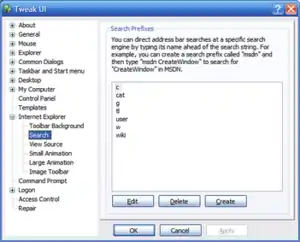Tweak UI
Tweak UI is a free application, released in 1996 by Microsoft for customizing the Microsoft Windows operating system's user interface. Tweak UI modifies the Windows Registry in the same way as a user could edit it manually with a program such as RegEdit, but provides a simple graphical user interface that does not need knowledge of the registry structure, is quicker and easier to use, and not susceptible to registry damage due to user error.
 Tweak UI running on Windows XP | |
| Original author(s) | Raymond Chen |
|---|---|
| Developer(s) | Microsoft |
| Initial release | 1996 |
| Stable release | 2.10
|
| Operating system | Microsoft Windows |
| Website | www |
Tweak UI was formerly downloadable free of charge from Microsoft's website. It is one of Microsoft's many non-supported PowerToys.
History
Tweak UI started as a control panel applet available for download on Microsoft's website, released shortly after the release of Windows 95. It was originally written by Raymond Chen and later included in Microsoft's Power Toys collection, a set of tools developed by Microsoft's Shell Development Team.[1]
An updated version of Tweak UI was included on the installation disc for Windows 98. According to Chen, this was deemed a "disaster" because it resulted in additional work for Microsoft's product-support teams when diagnosing problems.[2] Therefore, Microsoft did not include the applet in Windows 98 Second Edition.
With the release of Windows XP, the Tweak UI applet was retooled and re-released on Microsoft's website as a separate executable, TweakUI.exe It was again updated to version 2.10 for Windows XP Service Pack 1 and Windows Server 2003. Chen also wrote an updated Windows Vista version of the utility, but it was not released as it violated the policy of not making available unsupported software.[3]
An unofficial 64-bit version of Tweak UI was created by NeoSmart Technologies for Windows XP Professional x64 Edition.[4]
Features
Tweak UI allows the user to customize the user interface of the Windows operating system. The application has been heralded for enabling users with older, slower computers to turn off many aspects of the operating system's eye candy, such as fading menus, drop shadows, and cursor shadows. Tweak UI also includes numerous features to customise the way various base elements of the interface work, such as the taskbar and the desktop. The application also enables users to move the location of their Documents, Music and Pictures folders, and other system folders. It also includes various tools to repair elements of the operating system, such as icons, hot keys, the font folder, and file extension associations. It can be used to disable AutoPlay on one or more drives as well, which may be useful especially as external hard disk drives become popular.
Tweak UI can also set up Xmouse, a feature familiar to the users of the X Window System.
References
- Chen, Raymond (2 Feb 2005). "The history of the Windows PowerToys". The Old New Thing. Retrieved 14 August 2020.
- Chen, Raymond (2006). "Chapter Two: Selected Reminiscences on Windows 95". The Old New Thing (1st ed.). Pearson Education. pp. 32–33. ISBN 0-321-44030-7.
- Chen, Raymond (March 6, 2010). "What happens if I drag the mouse by exactly the amount specified by SM_CXDRAG?". The Old New Thing. Retrieved 2016-08-10.
- "TweakUI 64-Bit Edition". neosmart.net. NeoSmart Technologies. Retrieved 22 December 2012.
External links
- Paul Thurrott (October 8, 2004). "PowerToys for Windows XP Review". Retrieved 2014-08-06.
- "System Tools: TweakUI". Archived from the original on 2006-05-18. Retrieved 2006-01-22.